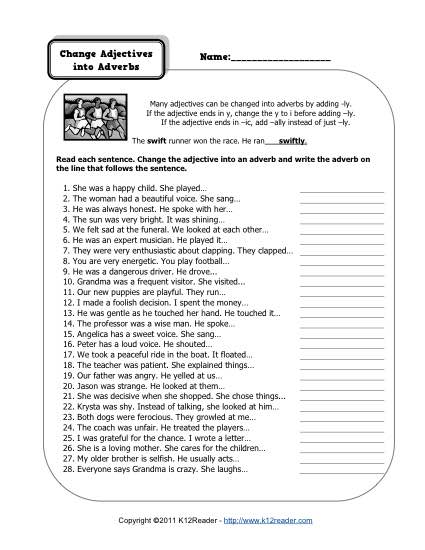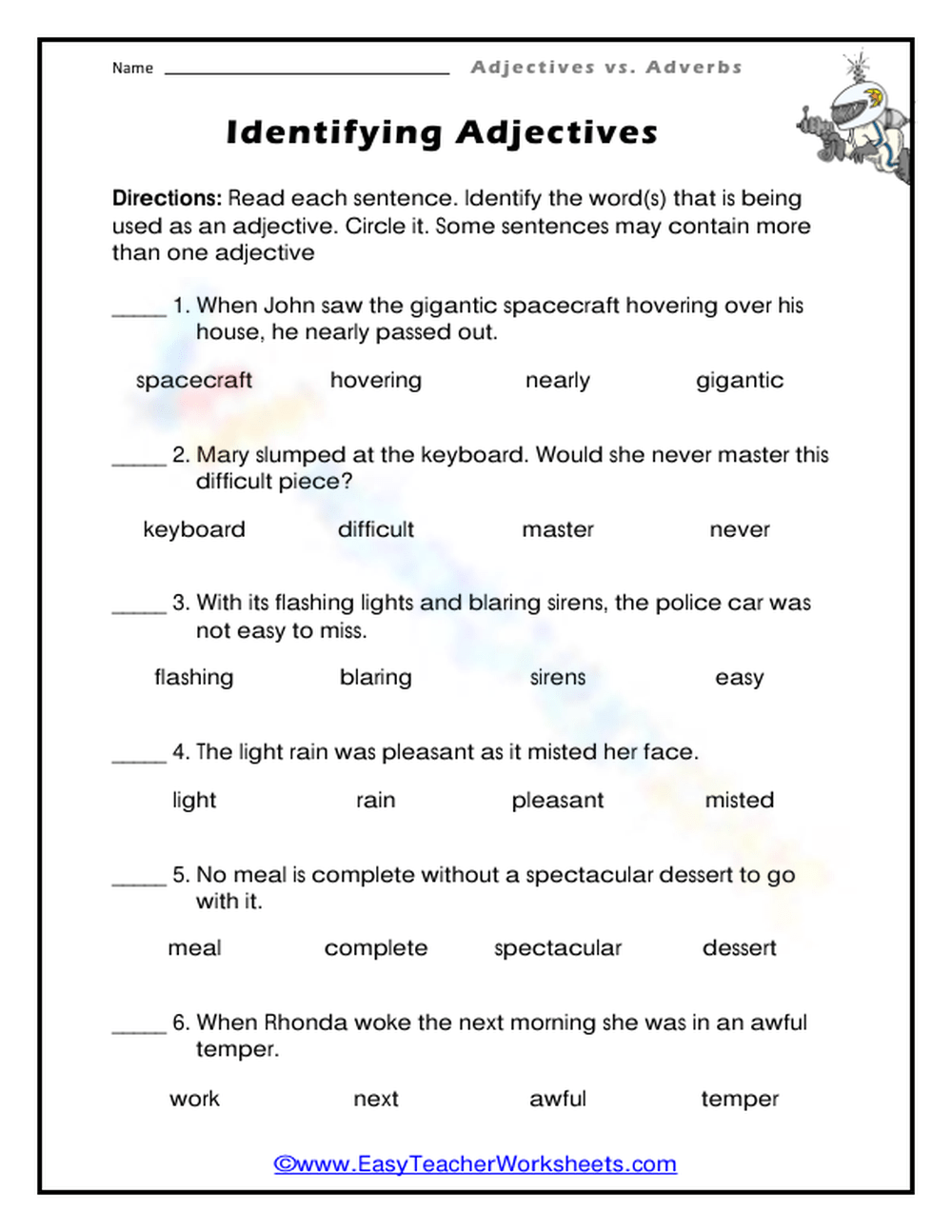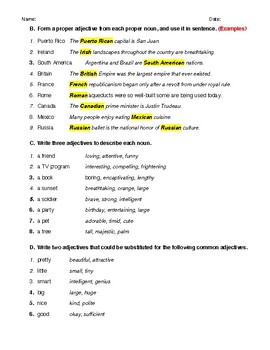
Mastering Descriptive Language: The Essential Role of Adjectives Worksheets for High School Students
In the vast and intricate landscape of the English language, adjectives stand as the vibrant brushstrokes that transform plain communication into vivid imagery. They are the words that add color, texture, and depth to our sentences, allowing us to describe the world with precision and evoke specific emotions in our audience. For high school students, mastering the nuanced use of adjectives is not merely an academic exercise; it is a critical skill that empowers them to craft compelling essays, articulate complex ideas, and engage effectively with literature. This article will delve into the profound impact of well-designed adjectives worksheets for high school students, exploring why these tools are indispensable for fostering linguistic prowess and enhancing overall communication skills.
The Indispensable Role of Adjectives in High School Communication
High school is a pivotal period for language development. Students transition from basic sentence construction to grappling with sophisticated concepts, argumentative essays, literary analysis, and even creative writing. In all these domains, adjectives play a crucial role:

- Enhancing Clarity and Precision: Without adjectives, descriptions remain vague. A "house" becomes a "dilapidated, sprawling house with peeling paint and broken windows." This specificity is vital for conveying exact meanings and avoiding ambiguity.
- Adding Detail and Imagery: Adjectives paint pictures with words. They allow writers to create immersive scenes, describe characters with depth, and bring abstract ideas to life. This is particularly important in narrative and descriptive writing.
- Conveying Tone and Emotion: Adjectives are powerful tools for expressing feelings and establishing the mood of a piece. Words like "somber," "jubilant," "ominous," or "serene" immediately set a particular emotional landscape.
- Strengthening Argumentation: In persuasive writing, carefully chosen adjectives can subtly influence a reader’s perception of an issue, person, or event. They can lend credibility, evoke empathy, or highlight a particular viewpoint.
- Improving Reading Comprehension and Analysis: Understanding how authors use adjectives is key to interpreting literary texts. Recognizing descriptive language helps students uncover themes, character motivations, and the author’s purpose.




Despite their undeniable importance, many high school students struggle with the effective and varied use of adjectives. Common issues include repetitive vocabulary (e.g., overusing "nice" or "good"), incorrect placement, confusion with adverbs, and an inability to choose the most impactful word for a given context. This is precisely where targeted practice through adjectives worksheets for high school becomes invaluable.
Why Adjectives Worksheets are Essential Learning Tools

The structured nature of adjectives worksheets for high school offers numerous pedagogical advantages that address the common challenges students face:
- Reinforcement of Concepts: Worksheets provide repetitive practice, which is crucial for solidifying grammatical rules and vocabulary acquisition. This helps students internalize when and how to use different types of adjectives.
- Targeted Skill Development: Unlike broad grammar lessons, worksheets can focus specifically on particular aspects of adjectives – identifying them, using comparatives and superlatives, understanding order of adjectives, or differentiating them from adverbs.
- Immediate Feedback and Self-Correction: Many worksheets come with answer keys, allowing students to check their work instantly. This immediate feedback loop is vital for learning, enabling students to understand their mistakes and correct them on the spot, rather than reinforcing errors.
- Variety of Exercises: Good worksheets offer diverse exercise types, preventing monotony and catering to different learning styles. This keeps students engaged and challenges them in multiple ways.
- Independent Learning: Worksheets are excellent tools for independent study, homework assignments, or even as supplementary material for students who need extra practice or enrichment.
- Vocabulary Expansion: Many exercises naturally introduce students to a wider range of descriptive words, expanding their active vocabulary and equipping them with more precise language.



Types of Effective Adjectives Worksheets for High School
One of the primary benefits of using diverse adjectives worksheets for high school is their ability to address different learning styles and target specific grammatical nuances. Here are several types that prove particularly effective:
-
Identification and Definition Worksheets:
- Focus: Helping students recognize adjectives in sentences and understand their function.
- Exercises: Underlining adjectives, circling nouns they modify, defining adjectives from context, or categorizing adjectives by type (e.g., descriptive, possessive, demonstrative).
- Example: "Underline all the adjectives in the following sentences: ‘The ancient castle stood on a tall hill, overlooking the sparkling river.’"
-
Comparative and Superlative Adjectives Worksheets:
- Focus: Mastering the correct formation and usage of comparative (-er, more) and superlative (-est, most) forms.
- Exercises: Completing sentences with the correct form of an adjective, transforming positive adjectives into comparative/superlative, or correcting errors in sentences.
- Example: "Complete the sentence: ‘Mount Everest is the (tall) mountain in the world.’ ‘My dog is (friendly) than yours.’"
-
Order of Adjectives Worksheets:
- Focus: Understanding the conventional sequence of adjectives when multiple adjectives modify a single noun (e.g., opinion, size, age, shape, color, origin, material, purpose).
- Exercises: Rearranging scrambled adjectives to form grammatically correct and natural-sounding phrases, or writing sentences that correctly use multiple adjectives.
- Example: "Rearrange the adjectives: ‘a (wooden, small, old) box’ -> ‘a small old wooden box’."
-
Adjectives from Nouns/Verbs Worksheets:
- Focus: Building vocabulary by showing how adjectives can be derived from other parts of speech.
- Exercises: Converting given nouns or verbs into their adjective forms, or filling in blanks with the correct adjective form of a root word.
- Example: "Transform the word: ‘beauty’ (noun) -> ‘beautiful’ (adjective); ‘create’ (verb) -> ‘creative’ (adjective)."
-
Descriptive Writing Prompts with Adjective Focus:
- Focus: Applying adjective knowledge in a creative, contextualized manner.
- Exercises: Providing a picture or scenario and asking students to write a paragraph using a minimum number of specific adjectives, or challenging them to describe an object without using its name, relying solely on adjectives.
- Example: "Describe your favorite place using at least five different adjectives. Focus on sensory details."
-
Adjective vs. Adverb Differentiation Worksheets:
- Focus: Clarifying the common confusion between adjectives (modifying nouns/pronouns) and adverbs (modifying verbs, adjectives, or other adverbs).
- Exercises: Identifying whether a highlighted word is an adjective or adverb, choosing between adjective/adverb forms to complete sentences, or correcting sentences where they are misused.
- Example: "Circle the correct word: ‘He sings (good/well).’ ‘She feels (bad/badly) about the news.’"
-
Error Correction and Editing Worksheets:
- Focus: Developing critical editing skills related to adjective usage.
- Exercises: Identifying and correcting errors in adjective placement, formation, or usage within sentences or short paragraphs.
- Example: "Correct the error: ‘The more difficultest test was math.’"
Designing and Selecting Effective Adjectives Worksheets
To maximize their impact, adjectives worksheets for high school should be thoughtfully designed and selected:
- Age-Appropriate and Engaging Content: While focusing on grammar, the content should resonate with high school interests. Use relevant examples, scenarios, or literary excerpts.
- Clear Instructions: Ambiguous instructions can hinder learning. Ensure that students understand exactly what is expected of them.
- Varied Difficulty Levels: Offer a range of exercises, from basic identification to more complex application, to cater to diverse student abilities.
- Real-World Context: Whenever possible, embed adjective usage in contexts that mimic real-life communication, such as analyzing advertisements, describing historical events, or critiquing art.
- Visual Appeal: Well-organized layouts, clear fonts, and minimal clutter can make worksheets less intimidating and more inviting.
- Answer Keys: Crucial for self-assessment and reducing teacher workload.
- Integration with Other Skills: Design worksheets that encourage not just grammar practice but also critical thinking, vocabulary building, and even creative expression.
Integrating Adjectives Worksheets into the Curriculum
Integrating adjectives worksheets for high school effectively into the curriculum requires thoughtful planning:
- Warm-Up Activities: A short worksheet at the beginning of a class can serve as a quick review or a diagnostic tool to gauge students’ understanding before a new lesson.
- In-Class Practice: Worksheets can provide structured practice after a lesson on adjectives, allowing students to apply new concepts immediately.
- Homework Assignments: Reinforce learning outside the classroom.
- Review for Assessments: Worksheets are excellent for consolidating knowledge before quizzes or exams.
- Differentiated Instruction: Provide different worksheets to students based on their needs – remedial practice for those struggling, or advanced exercises for those who have mastered the basics.
- Collaborative Learning: Some worksheets can be completed in pairs or small groups, fostering peer learning and discussion.
Beyond Worksheets: A Holistic Approach to Adjective Mastery
While worksheets are powerful tools, they should be part of a broader, holistic approach to language instruction. To truly master adjectives, high school students also need:
- Extensive Reading: Exposure to rich, descriptive language in literature helps students internalize effective adjective use.
- Creative Writing Opportunities: Encouraging students to write narratives, poems, or descriptive essays provides a natural context for applying their adjective knowledge.
- Peer Review: Students can learn a great deal from analyzing and providing feedback on each other’s use of descriptive language.
- Oral Communication: Encouraging students to use precise adjectives in presentations or debates can enhance their verbal fluency.
- Vocabulary Building Strategies: Direct instruction on synonyms, antonyms, and word nuances can significantly expand their adjective repertoire.
- Technology Integration: Online grammar exercises, interactive quizzes, and digital writing tools with feedback features can complement traditional worksheets.
Conclusion
The journey to linguistic proficiency in high school is multifaceted, requiring a blend of direct instruction, meaningful application, and consistent practice. Adjectives, though seemingly small words, wield immense power in shaping meaning, conveying emotion, and creating vivid imagery. The judicious use of adjectives worksheets for high school serves as a cornerstone in this journey, providing students with the structured, targeted practice they need to confidently identify, understand, and effectively employ these vital descriptive tools. By integrating well-designed worksheets into a comprehensive language arts curriculum, educators can empower high school students to become not just proficient communicators, but truly masterful wordsmiths, capable of painting their ideas with the full spectrum of linguistic color.
